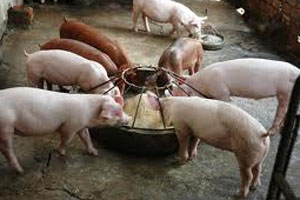Insects as sustainable raw material in pig feed

Insects can be a permanent part of pig and poultry feed according to a feasibility study of Wageningen University, funded by the Dutch Ministry of Economics, Agriculture & Innovation.
Technically, the use of insects as a sustainable raw protein in pig and poultry is feasible. The main obstacles before insects widely can be used as feed material are within the fields of legislation and regulation and the speed in which scaling up of production and cost reduction can be achieved.
In the Netherlands, approximately 18 companies produce insects at a small scale produce insects for zoos and pet stores. The final product can be insect flour, or a water-insoluble protein fraction.
The most suitable species for large scale production are: black soldier fly, housefly and the yellow mealworm.
The crude protein level of insects varied significantly between and within the species and life stages. The highest crude protein content was found in the pupa of the house fly (65.7% of DM) and the lowest levels in the larvae of the black soldier fly (38.9% of DM).
Upscaling
When insects would replace 5% of the feed for broilers in the Netherlands, then an amount of about 75,000 tonnes of insects would be needed. A viable production unit of insects can supply about 1 tonne per day t (i.e 365 tonnes per year). For this production volume, about 200 of small scale insects companies would be needed. For large-scale application, therefore further upscaling is a must.
Legislation
In terms of legislation there are still some barriers to actually use insects as raw material in animal feed. Insects are considered animal protein and as such due to current BSE legislation not permitted to be used in feed for pigs and poultry.
Also the GMP +-certification must be adapted for insects.
The most common proteins in pig and poultry feeds are fishmeal, soybean meal, sunflower seed meal and rapeseed meal. Since global demand for animal protein for human consumption increases and the price of these commodities is also on the rise.
Alternative proteins for livestock commodities are therefore desirable. Insects can be a sustainable alternative protein-rich raw material, in particular when they are grown on substrates of organic waste and by-products.
Insects are cold blooded and can therefore efficiently upgrade low-value biomass into high-quality protein.
Protein content
In the Netherlands, approximately 18 companies produce insects at a small scale produce insects for zoos and pet stores. The final product can be insect flour, or a water-insoluble protein fraction.
The most suitable species for large scale production are: black soldier fly, housefly and the yellow mealworm.
The crude protein level of insects varied significantly between and within the species and life stages. The highest crude protein content was found in the pupa of the house fly (65.7% of DM) and the lowest levels in the larvae of the black soldier fly (38.9% of DM).
Upscaling
When insects would replace 5% of the feed for broilers in the Netherlands, then an amount of about 75,000 tonnes of insects would be needed. A viable production unit of insects can supply about 1 tonne per day t (i.e 365 tonnes per year). For this production volume, about 200 of small scale insects companies would be needed. For large-scale application, therefore further upscaling is a must.
Legislation
In terms of legislation there are still some barriers to actually use insects as raw material in animal feed. Insects are considered animal protein and as such due to current BSE legislation not permitted to be used in feed for pigs and poultry.
Also the GMP +-certification must be adapted for insects.







